Your Guide to a Sugar Allowance Calculator
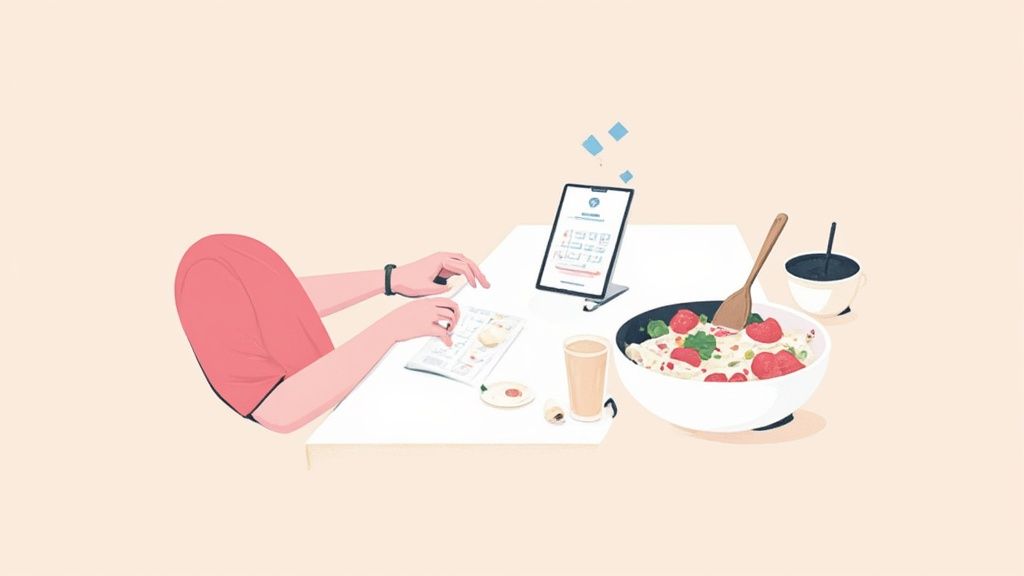
So, what exactly is a personal sugar allowance? Think of it as your daily "budget" for added sugars—the kind stirred into your coffee, hidden in sauces, or packed into sodas and pastries. We're not talking about the natural sugars found in a banana or a glass of milk.
A sugar allowance calculator simply does the math for you, factoring in your age, gender, and how active you are to give you a clear daily limit. It's an incredibly useful tool for anyone looking to get a handle on their sugar intake.
Your Daily Sugar Budget: What's a Healthy Limit?
Let's get straight to the point. A healthy sugar allowance is a specific, personalized target for managing how much added sugar you eat. Why the focus on added sugar? Because that's what most health experts agree we're getting way too much of.
Excess sugar is a massive global issue. To put it in perspective, worldwide sugar consumption is expected to hit a staggering 178.79 million metric tons for the 2024/25 season. You can dig into the numbers yourself and explore the global sugar consumption trends on Statista.com. With sugary products everywhere, having your own daily target is more important than ever.
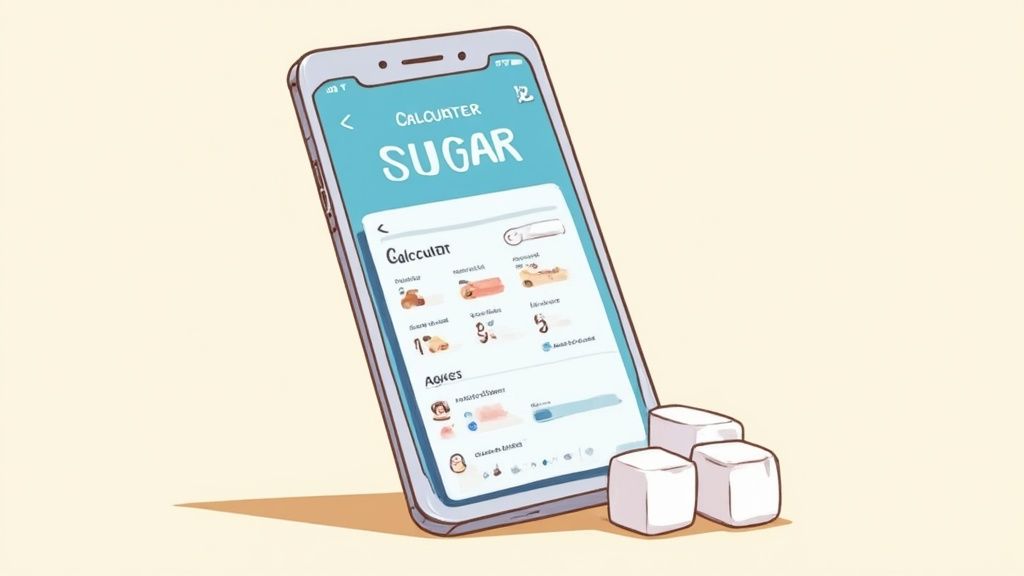
A Quick Look at General Health Guidelines
Before you calculate your personal number, it helps to know the general recommendations from trusted sources. The American Heart Association (AHA) offers some very clear, science-backed guidelines that serve as a great starting point.
Key Takeaway: The AHA's core advice is that added sugars should make up less than 10% of your total daily calories. For most people, hitting this target means making some significant, but achievable, changes.
To make it even simpler, the AHA breaks down the maximum daily limits like this:
| Group | Maximum Grams per Day | Maximum Teaspoons per Day | Maximum Calories per Day |
|---|---|---|---|
| Men | 36 grams | 9 teaspoons | 150 calories |
| Women | 25 grams | 6 teaspoons | 100 calories |
| Children (2-18) | 25 grams | 6 teaspoons | 100 calories |
These numbers are a fantastic baseline. From here, you can use a calculator to fine-tune your goal based on your own body and lifestyle, giving you a much more accurate and practical number to aim for each day.
Using a Sugar Calculator to Find Your Daily Limit
So, how do you go from those general health guidelines to a specific number that actually works for you? This is where a sugar allowance calculator is a game-changer. It takes all the guesswork out of the process by using your personal details to give you a clear daily target.
Think about it this way: a 35-year-old woman who’s moderately active will have a completely different sugar limit than a sedentary person or a professional athlete. A good calculator takes these individual factors into account to give you a number that’s genuinely useful.
How It Figures Out Your Personal Number
Most sugar allowance calculators need a few key details to work their magic. Each piece of information helps customize the recommendation to your specific body and lifestyle.
You'll typically be asked for:
- Your Age and Gender: Our metabolic rates and dietary needs naturally change as we age and differ between men and women.
- Your Current Weight: Body weight plays a big role in your total daily energy needs.
- Your Activity Level: This one is huge. Someone with a desk job simply doesn't burn energy the same way a construction worker or a person hitting the gym five times a week does.
These inputs are then crunched to produce a clear, personalized daily limit.
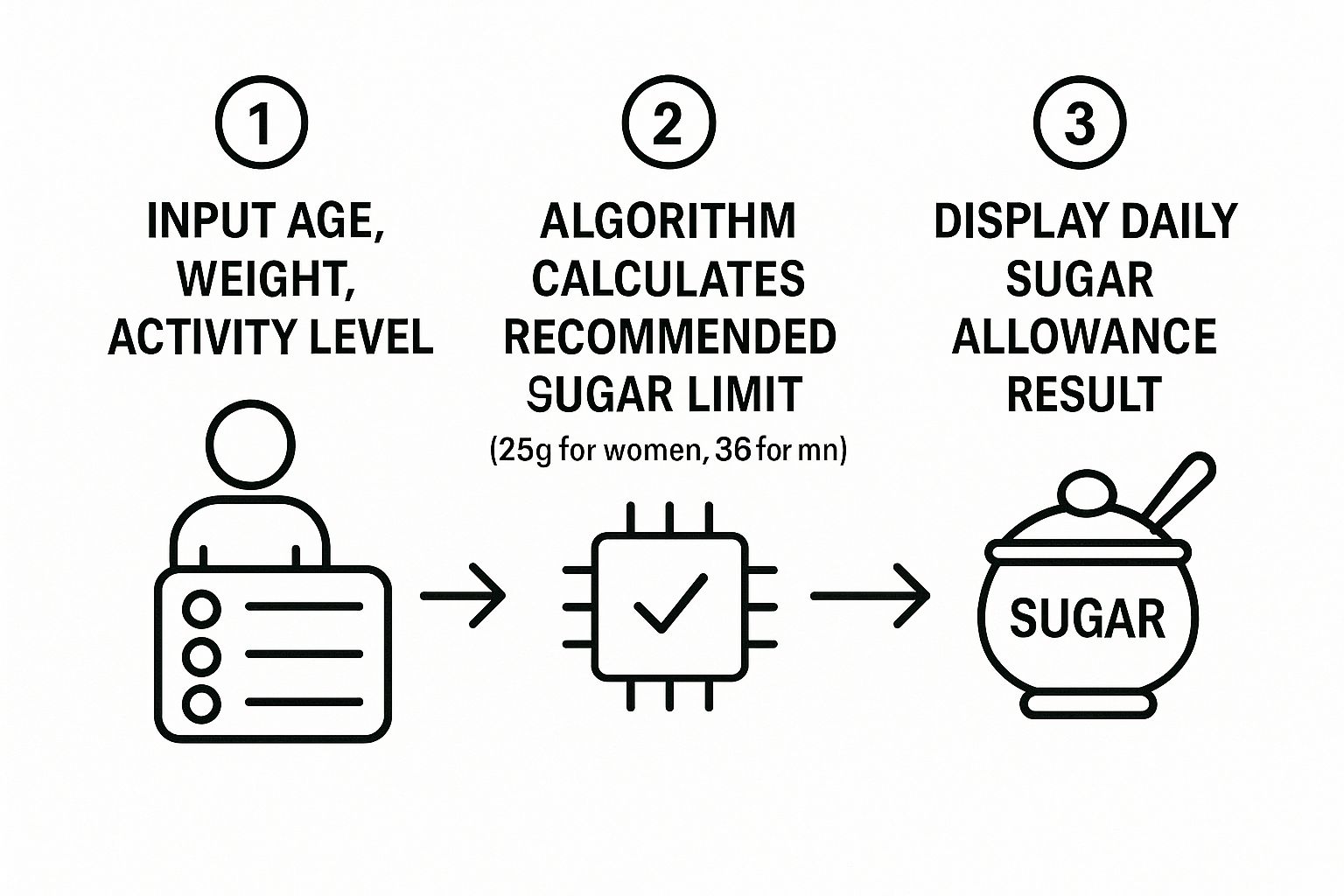
It’s a pretty simple exchange: you provide a bit of data, and in return, you get an actionable sugar limit in grams.
Turning Grams into Groceries
Okay, you've got your number. Let's say the calculator tells you your limit is 28 grams per day. What does that actually look like when you're at the grocery store? This is where you have to become a bit of a detective and start reading nutrition labels. It’s a skill that pays off big time.
When you flip over a package, you’re looking for one specific line: "Includes Added Sugars."
This number tells you precisely how much sugar was added during processing—the kind you really want to keep an eye on. For example, if a single serving of that "healthy" yogurt contains 10g of added sugars, you've just used up more than a third of your entire daily budget of 28g. It puts things into perspective pretty quickly
From Numbers on a Page to Real-Life Choices
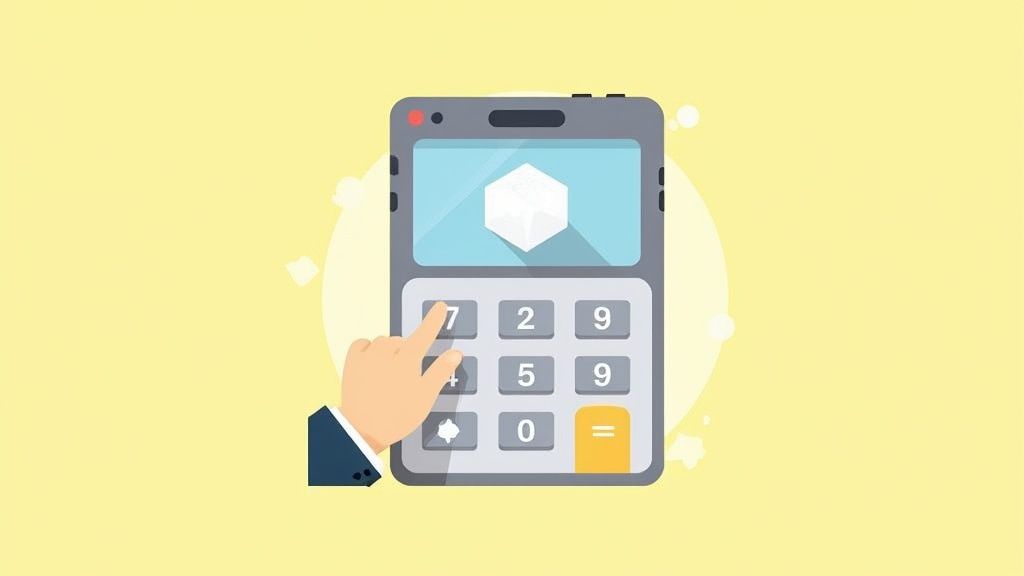
Knowing your personal sugar limit is a great start, but let's be honest—that number doesn't mean much until you see how it plays out with actual food. This is where the magic happens, when you connect the grams to your groceries and meals. Using a dedicated tool can make all the difference.
An app like StopSugar takes the guesswork out of the equation. Forget trying to keep a running tally in your head all day. When you log what you eat, you get instant, real-time feedback that helps build new, healthier habits.
Think about your morning coffee. Maybe you add two teaspoons of sugar, which is about 8 grams. Logging that right away shows you exactly how much of your daily budget you've just used. Seeing that visual cue on a dashboard makes the impact crystal clear.
Make Tracking a Daily Habit
For this to work long-term, consistency is everything. The whole point is to make tracking feel like a natural part of your day, not another chore on your to-do list. The easier it is, the more likely you are to keep it up.
The real power of tracking comes from making informed choices in the moment. When you can quickly see that a so-called "healthy" granola bar has 15 grams of added sugar, you can decide if it's really worth blowing half of your daily allowance.
To make tracking feel effortless, here are a few things that have worked for me:
- Log as you go. Don't wait until bedtime to try and remember what you ate for lunch. Log your meals right after you eat them while it's still fresh in your mind.
- Use the barcode scanner. This is a game-changer. Apps like StopSugar let you scan a product's barcode to instantly import its nutritional info, added sugars included. It saves so much time and manual entry.
- Plan for treats. If you know you're going out for dessert tonight, log it in the morning. This lets you see how to adjust your meals during the day so you can enjoy your treat without the guilt.
This kind of active tracking transforms the number from your sugar allowance calculator into a dynamic, practical guide. You'll quickly get a feel for the sugar "cost" of different foods, empowering you to make smarter choices without feeling overwhelmed or deprived.
Uncovering Hidden Sugars in Your Food
The toughest part of cutting back on sugar isn't skipping the obvious treats like cookies or soda. It’s the sugar you never even knew was there. Once you’ve figured out your daily target with a sugar allowance calculator, the real work begins: becoming a sugar detective. And trust me, you need to be one, because food manufacturers are experts at hiding the sweet stuff.
You'd be shocked where added sugars are hiding. They're in so many of the everyday foods we think of as healthy. That "all-natural" yogurt, your favorite brand of pasta sauce, or even that light vinaigrette dressing can be packed with sugar. This is why getting comfortable with reading nutrition labels is absolutely essential.
Learning to Read the Label
When you pick up a package, flip it over and train your eyes to find the "Added Sugars" line on the nutrition facts panel. This number is your best friend. It tells you exactly how much sugar was put in during processing, separate from what's naturally there (like in fruit or milk). Hitting your daily goal is all about managing this number.
But here’s the tricky part: sugar goes by many names. Companies know that most of us just scan for the word "sugar," so they use all sorts of aliases. Be on the lookout for these culprits in the ingredients list:
- High-fructose corn syrup
- Dextrose or maltodextrin
- Cane juice or evaporated cane juice
- Barley malt or rice syrup
Here's a tip from experience: The ingredients list is always in order by weight. If a sugar-like name appears in the first two or three spots, that’s a huge red flag. It means the product is likely loaded with sugar, and you can often make a quick decision to put it back without even checking the numbers.
A Real-World Grocery Store Comparison
Let's walk through a common choice in the dairy aisle: yogurt. You might grab a plain Greek yogurt and see it has 4 grams of sugar. That's just the naturally occurring lactose from the milk, so no big deal. But right next to it, a popular fruit-flavored yogurt could list 18 grams of sugar, with 12 grams of that being "Added Sugars."
That single serving of flavored yogurt could blow through almost half the recommended daily limit for women. It’s little swaps like this that make all the difference. You can find more examples just like this in our guide to hidden sugar in common foods.
The reason we have to be so careful is simple economics. Sugar is a massive global business, projected to grow from $68.23 billion in 2024 to $121.08 billion by 2033, according to a recent sugar market growth forecast on GlobeNewswire.com. This growth is driven by our demand for quick, processed foods. Knowing this makes your personal diligence in the supermarket more important than ever. By learning to spot these hidden sugars, you're taking back control and making choices that are truly good for you.
Simple Swaps to Stay Within Your Limit
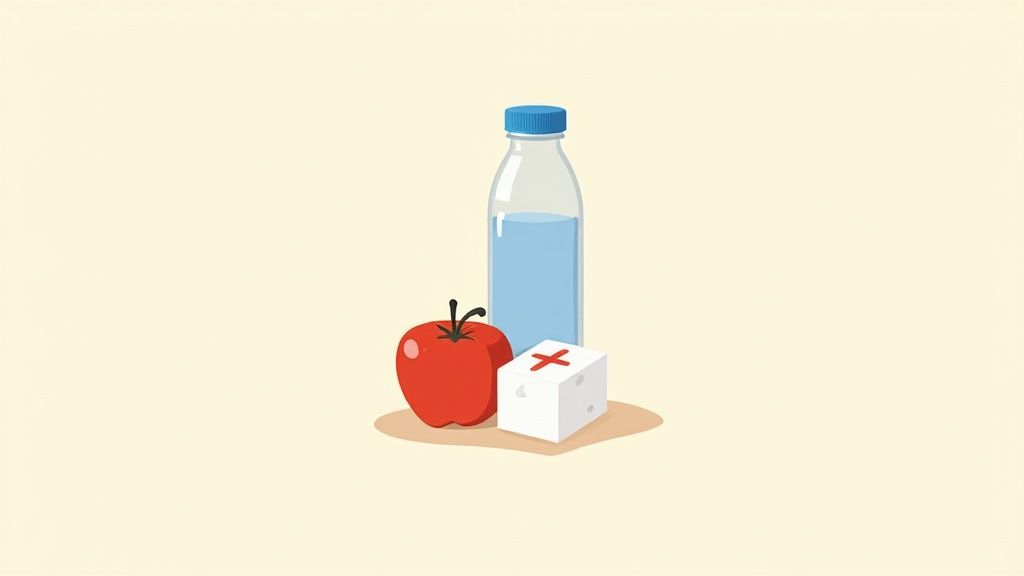
So, you've used a sugar allowance calculator and know your daily number. Now what? The thought of cutting back on sugar can feel daunting, making you picture a future of bland, boring food. But it absolutely doesn't have to be that way.
The secret isn't about deprivation; it's about making smart, simple swaps. This is all about focusing on what you can add to your meals to make them delicious and satisfying, not just what you need to remove.
For example, think about that afternoon soda habit. A single can of cola can pack a shocking 39 grams of sugar, blowing a huge hole in your daily budget. Instead of grabbing that can, try a sparkling water with a squeeze of fresh lime. You still get the bubbles and a refreshing taste, but you've just sidestepped a major sugar bomb. It's small changes like this that add up to big results.
Get Creative With Sweetness
Another easy place to make a big impact is with your morning coffee or oatmeal. Before you reach for the sugar bowl out of habit, pause and think about flavor. There are so many ways to add a sense of sweetness without piling on the sugar.
- Lean on Spices: A sprinkle of cinnamon or nutmeg can completely change the game. Cinnamon is fantastic in coffee and on top of yogurt, adding a warm sweetness all on its own.
- Try Natural Extracts: Just a few drops of pure vanilla or almond extract can give smoothies, yogurt, or even baked goods a rich, dessert-like flavor profile.
- Stick With Whole Fruit: Instead of buying fruit-on-the-bottom yogurt, which is often loaded with added sugar, start with plain Greek yogurt. Then, top it with a handful of fresh berries for natural sweetness and a dose of fiber.
Don't get caught up in the idea of being perfect. The goal is progress. Having a treat here and there is completely normal and won't derail your journey. Just get back on track with your next meal.
Making these conscious choices is more important than ever. With global sugar production projected to reach nearly 188.8 million tonnes by 2026, sugary products are everywhere and cheaper than ever. This makes finding enjoyable, low-sugar alternatives the key to your long-term health.
The best way to stick with your new goals is to make sure your food is still exciting. If you need some fresh ideas to get you started, check out our collection of easy sugar-free recipes. You'll find that staying within your limit is much easier when you're eating food you genuinely love.
Got Questions About Your Sugar Goal? We've Got Answers
Once you have your daily sugar number, a few questions always seem to come up. I see them all the time. Let's walk through some of the most common ones so you can feel totally confident as you start tracking.
What About the Sugar in Fruit and Milk? Do I Count That?
This is probably the number one question I get asked, and the short answer is no, you don't need to count the sugar in whole fruits and plain dairy.
Here’s why: The natural sugars in these foods, like fructose in an apple or lactose in milk, come packaged with fiber, vitamins, and protein. This built-in nutrition helps your body absorb the sugar slowly, preventing the sharp blood sugar spikes we want to avoid.
Your main target is added sugars. These are the sugars that manufacturers sneak into everything from pasta sauce to bread to, of course, desserts. So go ahead and enjoy that banana or a glass of milk without worry.
Is a Sugar Calculator Just Another Calorie Calculator?
Not at all. Think of it this way: a calorie calculator looks at your total energy intake for the entire day. It’s the big-picture budget.
A sugar allowance calculator is much more specific. It drills down to one particular part of that budget and tells you the absolute maximum amount that should come from added sugars. For most people, that magic number is keeping added sugars under 10% of your total daily calories. The calculator does the math for you, turning that percentage into a simple gram target you can actually track.
The Cravings Are Real. How Do I Handle Them?
Let’s be honest: the first week or two can be tough. Cravings are completely normal as your body adjusts. Don't panic!
The single best thing you can do is focus on eating balanced, satisfying meals. Plenty of protein, healthy fats, and fiber will keep your blood sugar stable and make you feel full. When you're not hungry, those desperate calls for a cookie get a lot quieter.
A few other tips from my experience:
- Hydrate first. We often mistake thirst for a sugar craving. Drink a big glass of water and wait 15 minutes.
- Have a healthy swap ready. A piece of fruit or a handful of berries can give you that touch of sweetness without derailing your day.
- Be patient. This gets so much easier. Your taste buds will literally change, and you'll start finding overly sweet foods less appealing.
If you need a few more ideas to get you through, our guide on how to stop sugar cravings naturally has some great, practical strategies.